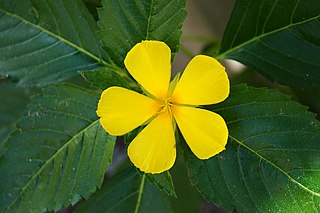
The Ulvophyceae or ulvophytes are a class of green algae, distinguished mainly on the basis of ultrastructural morphology, life cycle and molecular phylogenetic data. The sea lettuce, Ulva, belongs here. Other well-known members include Caulerpa, Codium, Acetabularia, Cladophora, Trentepohlia and Monostroma.

Turnera is a genus of flowering plants in the passionflower family, Passifloraceae. It contains more than 100 species native to tropical and subtropical America. The name honours English naturalist William Turner (1508–1568). It was previously placed in the family Turneraceae.

Turnera subulata is a species of flowering plant in the passionflower family known by the common names white buttercup, sulphur alder, politician's flower, dark-eyed turnera, and white alder. Despite its names, it is not related to the buttercups or the alders. It is native to Central and South America, from Panama south to Brazil. It is well known in many other places as an introduced species, such as Malaysia, Indonesia, several other Pacific Islands, the Caribbean, and Florida in the United States.

Adenoa is a monotypic genus of flowering plants belonging to Turneroideae (Passifloraceae).

Afroqueta is a genus of flowering plants belonging to Turneroideae (Passifloraceae). It is a monotypic group, consisting of Afroqueta capensis(Harv.) Thulin & Razafim.

Oxossia is a genus of flowering plants in the subfamily Turneroideae (Passifloraceae) consisting of 15 species. This genus was recently defined in 2019 after a phylogenetic analysis of Turnera justified the creation of the genus.
Oxossia albicans is a subshrub in the genus Oxossia. It is native to the wet tropics of eastern Brazil, specifically the Atlantic forest.
Oxossia annularis is a shrub of Oxossia Turneroideae (Passifloraceae) native to eastern Brazil. It is found in Caatinga, Cerrado, and Atlantic Forest.

Oxossia calyptrocarpa, a member of Turneroideae (Passifloraceae), is a shrub native to the wet tropics of eastern Brazil. It is found in the Caatinga, Cerrado, and Atlantic forest. It is 0.2-2.5 meter tall with highly plasticitic leaves and white to lilac flowers. It is a heterostylous species.
Oxossia capitata is a shrub native to the wet tropics of southern Brazil. It was previously classified as Turnera, however, recent phylogenetic analyses suggested the species should be placed in Oxossia.O. capitata has heterostylous white pointed flowers.
Oxossia dasystyla is a shrub native to southeast Brazil. It is native to the jungles and surrounding fields of Minas Gerais; specifically the Caatinga and Atlantic Forest.
Oxossia hatschbachii is a species of shrub in the genus Oxossia (Passifloraceae). It is native to the Atlantic Rainforest near Espírito Santo, Brazil. O. hatchbachii has heterostylous racemose flowers, ranging in color from white to red.
Oxossia hebepetala is shrub in the genus Oxossia (Passifloraceae). It is native to the Caatinga of Bahria and Piauí, Brazil.
Oxossia maracasana is a shrub in the genus Oxossia (Passifloraceae). It is native the Caatinga regions and Atlantic forest near Bahia, Brazil. It has white heterostylous flowers.
Oxossia marmorata is a shrub in the genus Oxossia (Passifloraceae). It is native to the Atlantic Rainforest of Brazil. It can be distinguished from other members of the genus by its yellow flowers. Similar to other members of Oxossia, O. marmorata has distylous flowers.
Oxossia pernambucensis is a shrub in the genus Oxossia (Passifloraceae). It is native to the Atlantic Rainforest of Brazil. The species is currently represented by a single population and thus is currently classified as critically endangered.
Oxossia princeps is a subshrub in the genus Oxossia (Passifloraceae). It is native to the savanna of Minas Gerais, Brazil. It is considered "rare", but its conservation classification is currently unknown.
Oxossia rubrobracteata is a shrub in the genus Oxossia (Passifloraceae). It is native to the Atlantic Rainforest of Brazil.
Oxossia schomburgkiana is a shrub in the genus Oxossia (Passifloraceae). It is native to the Amazon Rainforest of Brazil.
Oxossia spicata is a shrub in the genus Oxossia (Passifloraceae). It is native to the Atlantic Rainforest of Espírito Santo, Brazil. The species is known from three different populations, however, additional field work is needed to determine the conservation status of O. spicata.






